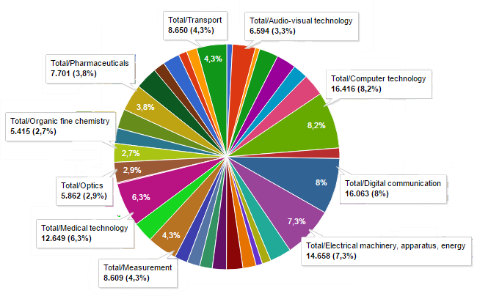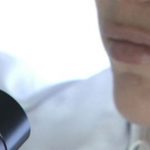BRPTO publishes new guidelines for examination of computer program implemented inventions
- 20 December 2016
- Articles
Nowadays, especially with the growing advancement of technology, innovation is highly associated with electronic and computer inventions. The growth of the sectors of microelectronics,telecommunications and nanotechnology, among others, caused a paradigm shift in different sectors, from production to services.
The importance of the electronics industry can be clearly seen when checking that the publication of PCT [1] applications in the year 2015 are mostly related to this technological area. Of the ten (10) most published technological areas, five (5) are electro-electronic. Moreover, the top three (3) largest technological areas are computers, digital communication and electrical machines, appliances and energy, the three (3) technologies representing almost a quarter of all publications of PCT applications in 2015 (a total of 23.5%).

Such technological shift has not always been accompanied by a change in legislation of Intellectual Property protection, especially in Brazil. In this sense, in March 2012, the Brazilian Patents and Trademarks Office (BRPTO) held a public consultation on the application of examination guidelines related to computer program implemented inventions. This consultation became, in July of the same year, a document that solidified the procedures for examining patent applications related to this type of technology, which was now published on December 6, 2016 as Resolution / BRPTO / PR No. 158, entitled “Guidelines for Examination of Computer Program implemented Inventions”.
RESOLUTION /BRPTO/PR Nº 158
This resolution has some important definitions in the computer implemented inventions area, since BRPTO Examiners commonly published different requirements for this type of technology, normally in a conflicting way for this type of technology.
One of the main points of Resolution PR 158 is the definition of “computer program per se”, which is excluded from patent protection by article 10 of the Brazilian Industrial Property Law (BRIPL) [2]. Such definition makes clear now something that was already usual, that it will only be considered a computer program per se the source codes of the software, not the method that can be defined by it.
It is important to remember that any Patent of Invention must produce a technical effect that solves a problem. The BRPTO per se defines some examples of technical effects achieved by computer program implemented inventions, such as optimization (execution times, hardware resources, memory usage, access to a database), enhancement of interface with a user (not merely aesthetic), file management, data switching, among others. Nevertheless, such effects must be due to changes in the method, not only in the source code, or creation will not be considered an invention.
Other important definitions are related to “mathematical methods”, “commercial, accounting, financial, educational, advertising, lottery or inspection methods”, “therapeutic or diagnostic methods for application in the human or animal body” and “presentation of information”. These definitions fit into what is commonly used in other countries, especially in relation to the European Patent Office.
Lastly, one of the most important definitions of the new Resolution PR 158 is related to the presentation of information, which includes readable medium. In such a definition, the BRPTO clearly defines that the readable medium that merely includes the method information is not patentable, however a readable medium that has new characteristics, for example, greater volume, due to the method used and a readable medium which performs specific steps may be considered as inventions by the BRPTO. Thus, it can be inferred that the way of writing the readable medium claims is extremely important for the BRPTO analysis. If the claim relates only to the foregoing claims, such as “…readable medium characterized in that it comprises a method as defined in the preceding claims…”, it may be objected and excluded from protection, while the same claim written differently, such as “…readable medium for execution on a computer characterized in that the program comprises the steps of…” will be considered for analysis.
CONCLUSION
The new Computer Program Implemented Invention Examination Directive comes in good time, as this type of technology has increased significantly in recent years and today is the largest technology area inpatent protection.
In addition, the BRPTO Examiners can now solidify and harmonize their analyzes, since the guidelines leave little room for interpretation, and the coordination personnel of the electric and electronic area has been working towards a unification of decisions around the guidelines, which certainly directs the Brazilian patent system to the European patent system. Obviously, the BRPTO in will not enable in the near future the use of source codes in claims like the North-American system, since IPL is clearly prohibitive in this regard.
Following this publications, with the harmonization of decisions, new guidelines, and possible new agreements (especially PPH agreements [3]) with other countries, we can expect a faster agility in the patent examinations of this technological fields and, therefore, a possible decrease in the backlog of this area on the next few years, which is one of the technical fields in which the examinations are more delayed in Brazil.
[1] Source: WIPO PCT statistics, http://ipstats.wipo.int/ipstatv2/pmhindex.htm?tab=pct [2] Art. 10. It is not considered an invention or utility model:V – computer programs per se;
[3] Patent Prosecution Highway (PPH) are treaties which expedite the prosecution of a patent application in the country, when applications from the same family have already been granted in other countries. The BRPTO is signing cooperation agreements with several countries, such as the United States, Japan, the United Kingdom and the European Patent Office, and it is expected that these agreements will be transformed into PPH treaties in the near future.Connect to our music








